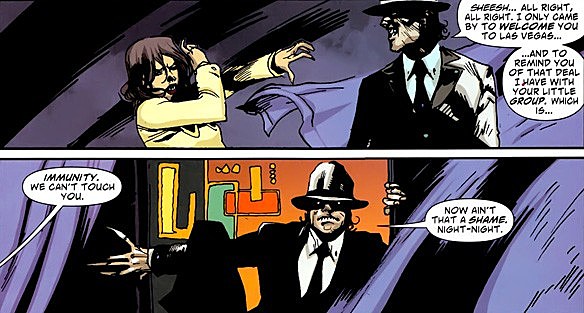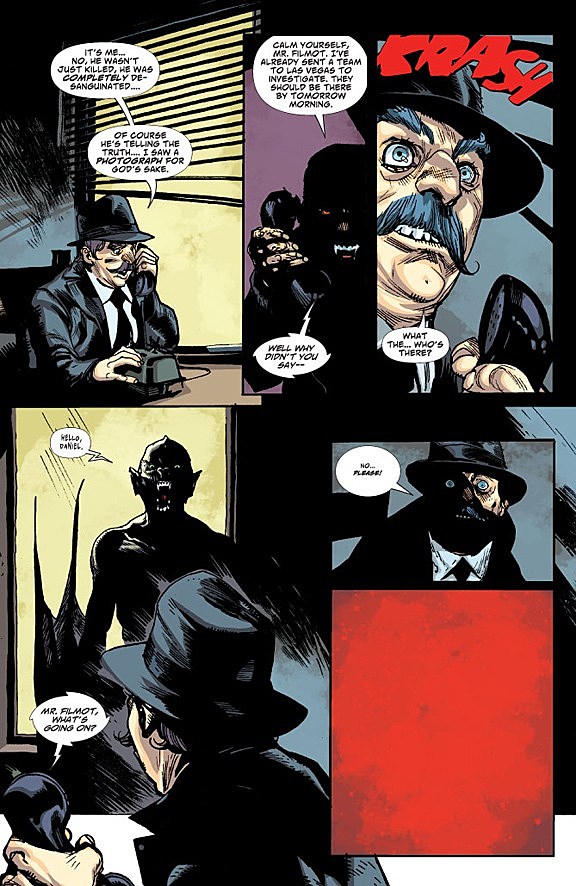
Why We Love Scott Snyder & Rafael Albuquerque’s ‘American Vampire’

A man and a woman in love seek out a safe place to hide where their past can't catch up to them. A wild west outlaw changes with the times to adjust to the criminal underworld of a new era. A police chief's family values are tested by a case so strange and gruesome he fears he's in over his head. These aren't different stories, but rather different pieces of the increasingly complex and rewarding narrative being woven in Scott Snyder and Rafael Albuquerque's American Vampire.
Vertigo recently released the second volume of the acclaimed series, and it hints at a much larger ongoing story involving the growth of America across the 20th century. But while American Vampire's scope of time and place is vast, the stories of its characters are intensely small and personal, intricately constructed episodes that deal with powerfully emotional concepts like love and trust and ensure the decades-spanning epic is connected to fascinating personalities. In other words, American Vampire is a book you should be reading, and we're going to tell you why.As you may have gathered from the title, American Vampire involves vampires. Hold on, wait, come back here, keep reading! It's not that kind of vampire story or another one of those supposed "not your typical vampire stories" that means as much as superhero comics that promise "nothing will ever be the same again." American Vampire is not your typical vampire story because its creators realize that "vampire" shouldn't be regarded as a genre, but instead as an opportunity to explore and amplify the character traits of the sharp-toothed, blood-drinking parts of its cast as they develop and interact over a very, very long time, and in stories that change genre from western to romance to action to mystery.
That is precisely what happens in volume two of American Vampire: the book departs from the origin story of its first collection (co-written by Stephen King and on sale now) and spreading out to show a larger world with new players and increasingly complex roles for its main characters.

American Vampire Vol. 1 introduced Pearl Jones, a 920s actress trying to make it big in Hollywood who goes to the wrong party with particularly cutthroat producers and ends up with fangs and a thirst for blood. The book also introduced Skinner Sweet, the 1880s Wild West outlaw who became the first peculiarly American vampire. Snyder shared writing responsibilities with Stephen King, who came on board to tell Sweet's origin story.
In volume two, Snyder has sole writing responsibility and we finally begin to understand the larger American Vampire story and where it may be headed. In this world, there are different types of vampires with different powers and weaknesses. Skinner's the first vampire of the American line, able to walk unharmed in the sunlight and weak during a full moon. He and Pearl are seen as threats by the old line of European vampires, rushing to spread their power networks across the Atlantic.

As the blood and fangs crime noir story unfolds, Snyder and Albuquerque als develop an organization dedicated to killing vampires and a vampire bloodline distinct from the Americans and the Europeans, slowly adding more layers to the book's setting. There's also a subplot surrounding Pearl and her mortal husband Henry, whose efforts to live happily ever after in peace and quiet are threatened when vampire hunters pressure the couple for information on Skinner.
The dynamic of Pearl's reverse high school girl dilemma, in that Henry keeps getting older but she's still the same age, is the core of the second story. With Mateus Santoluco this time providing the artwork, Pearl and Henry's quiet life is this time threatened by an old, angry enemy. Skinner, meanwhile, continues to be more agent of chaos than outright villain, someone so bored by his immortality that he does horrible things because he's curious to see where the outward spiral of terrible consequences will lead next.

Vampires are something like the literary equivalent of bacon right now. There are some people who'll buy and consume absolutely anything and everything into which vampires are inserted, and there are other people so put off by that first group that they're instantly by the very mention of the word. And although bacon is unhealthy for you in large doses, it is delicious and worth eating when prepared well with the right other ingredients.
Similarly, vampires possess qualities that mix well with the right story elements. They present great opportunities to explore concepts like humanity's literal and figurative desires for immortality, the extreme lengths people are willing to go for self-preservation, and the tendency of the strong to prey upon the weak. They're also a great way to present a narrative that can span decades or even centuries, watching how characters cope with the world they knew aging and changing around them, all of which Snyder explores in American Vampire.
If you haven't given American Vampire a look yet, or came away from the first volume unsure about the series, now's a great time to pick it up, particularly if you've been enjoying Snyder's run on Detective Comics and his recently launched Batman: Gates of Gotham. His skill with character work and with stories that slowly build to a big pay off were on display here before he brought them to Gotham City, and the artwork by Albuquerque is stellar as well.
With the next story arc jumping into the '40s and World War II, American Vampire promises to continue to expand its scope and introduce new characters and complications to the growing list of grudges and debts involving Pearl and Skinner. The book is more recognition of the fact that "vampire" is not a genre, but instead a trope that allows it to explore themes and characters across genres and eras gives me a lot of faith in where it's going.
American Vampire volumes 1 and 2 are on sale now in finer comics shops and bookstores, and can be purchased online from Things From Another World.
The following is a complete sequence from American Vampire Vol. 2, courtesy of Vertigo.







More From ComicsAlliance



![DC Unveils Covers And Solicitations For June’s Bat-Books [Exclusive]](http://townsquare.media/site/622/files/2017/03/Batbooks.png?w=980&q=75)
![‘All Star Batman’ #8 Will Knock You Upside The Head With A Robot Flamingo [Preview]](http://townsquare.media/site/622/files/2017/02/ASBAR08.jpg?w=980&q=75)
![Image To Add 25 Complete And Ongoing Series To Comixology Unlimited [Exclusive]](http://townsquare.media/site/622/files/2017/02/Image-Featured1.png?w=980&q=75)

![Sith Versus Rathtars In ‘Star Wars: Darth Maul’ #1 [Preview]](http://townsquare.media/site/622/files/2017/01/Darth_Maul_1_Featured.jpg?w=980&q=75)
![Scott Snyder Reveals How He Keeps The Villains Scary In ‘All-Star Batman’ [Interview]](http://townsquare.media/site/622/files/2016/12/ASB0.jpg?w=980&q=75)
